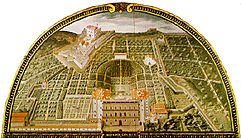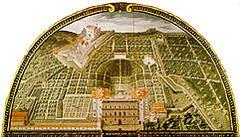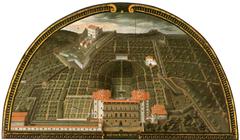
Forte di Belvedere: Visiting Hours, Tickets, and Florence Historical Sites Guide
Date: 14/06/2025
Introduction
Forte di Belvedere—also known as the Fortress of Santa Maria in San Giorgio del Belvedere—is one of Florence’s most iconic landmarks, blending Renaissance military ingenuity with cultural vibrancy. Perched atop Boboli Hill, the fortress was constructed between 1590 and 1595 under Grand Duke Ferdinando I de’ Medici and designed by Bernardo Buontalenti. Today, it offers not only commanding views of Florence but also serves as a hub for contemporary art exhibitions and seasonal events, making it a cornerstone of any Florentine itinerary (Forte Belvedere website; MuseFirenze; Tuscany Planet).
This detailed guide will help you explore Forte di Belvedere’s rich history, architecture, visiting information, accessibility, and nearby attractions—ensuring a memorable experience at one of Florence’s most remarkable historical sites.
Table of Contents
- Introduction
- Historical Background and Medici Legacy
- Architectural Highlights
- Role in Florentine History
- Visiting Information
- Key On-site Experiences
- Nearby Attractions
- Frequently Asked Questions (FAQ)
- Summary and Recommendations
- References
Historical Background and Medici Legacy
Forte di Belvedere was commissioned by Grand Duke Ferdinando I de’ Medici as both a military stronghold and a visual assertion of Medici power. Its construction, directed by architect Bernardo Buontalenti, embodies the dual priorities of protection and prestige, securing the ruling family and reinforcing their dominance over Florence (Nomads Travel Guide; Within Florence; Tuscany Planet). Secret passages, such as the Vasari Corridor, linked the fortress to the Medici palaces, enabling safe movement during times of unrest (Holidify).
The fortress also played a symbolic role, serving as a deterrent against rebellion and a visible reminder of Medici influence. Its close connection to the Boboli Gardens and Pitti Palace reflects the Medici family’s integrated approach to urban planning and personal security.
Architectural Highlights
Forte di Belvedere is a masterpiece of late Renaissance military architecture. Its angular bastions, robust ramparts, and strategic placement on Florence’s highest hill were designed to withstand 16th-century artillery and provide panoramic surveillance of the city (Wikipedia). At its core stands the Palazzina di Belvedere, a villa attributed to Bartolomeo Ammannati, serving as a luxurious yet fortified retreat for the Medici (Nomads Travel Guide). The fortress’s design balances military function with Renaissance aesthetics, offering both defensive capability and visual harmony with the surrounding landscape.
Role in Florentine History
Forte di Belvedere was completed during Florence’s transition from medieval city-state to a grand ducal capital. Though it never faced direct assault, its very presence deterred insurrection and provided a last-resort refuge for the Medici during periods of instability (Within Florence). Over centuries, the fortress adapted to changing military and civic roles, serving as a garrison, site for scientific observation (Galileo Galilei is known to have worked nearby), and eventually as a public venue for art and community events (Holidify).
Visiting Information
Opening Hours
- Seasonal Operation: Generally open from late spring to autumn (April/June–October).
- Hours: Typically 10:00 AM–7:00 or 8:00 PM (last entry one hour before closing).
- Closed: Mondays and during winter months (November–March). Always check the official website for current schedules and event-specific variations.
Tickets and Admission
- Outdoor Areas: Entry is often free.
- Special Exhibitions: Tickets required, usually €8–€10 for adults, with reductions for children, seniors, and students (Tuscany Planet; Firenze Made in Tuscany).
- Guided Tours: Optional, typically €3–€5, available in multiple languages. Advance booking is recommended, especially during peak season (MuseFirenze).
- Online Booking: Strongly encouraged during high season to avoid queues (European Traveler).
- Combined Passes: Firenze Card and similar passes may include access to other sites.
Accessibility
- Mobility: The fortress is partially accessible; some historic areas are challenging due to uneven surfaces, stairs, and steep paths. Ramps provide access to select terraces and exhibition areas, but not all spaces are reachable for visitors with mobility issues (MuseFirenze).
- Arrival: Accessible on foot via a steep climb from Oltrarno or by taxi. Limited parking nearby.
Travel Tips
- Best Times: Early morning and late afternoon offer ideal lighting, cooler temperatures, and fewer crowds. Sunset is especially popular for panoramic photography (The Travel Folk; The Crazy Tourist).
- Footwear: Wear comfortable shoes for walking uphill and over uneven terrain.
- Weather: Bring water and sun protection during summer; dress in layers during spring and autumn (The Geographical Cure).
- Children: Supervise on terraces with low walls or open edges.
- Photography: Allowed throughout the fortress, but tripods may be restricted during busy times or exhibitions.
Key On-site Experiences
Panoramic Views
Forte di Belvedere offers some of the best 360-degree views of Florence’s historic skyline, including the Duomo, Palazzo Vecchio, and the Arno River. The terraces and ramparts are ideal for enjoying the city’s beauty and capturing memorable photographs (Evendo; Better Cities).
Art Exhibitions and Cultural Events
The fortress is a premier venue for contemporary art, hosting regular exhibitions and performances by internationally acclaimed artists, as well as open-air festivals and summer events (MuseFirenze; Tuscany Planet). These events bridge Florence’s artistic heritage with its vibrant present.
Guided Tours
Guided tours provide rich insights into the fortress’s history, architecture, and cultural significance. Both private and group options are available, often including combined itineraries with nearby sites (MuseFirenze).
Amenities
Facilities include restrooms, a seasonal café or refreshment kiosk, and shaded seating. No restaurant is on-site, but the Oltrarno district nearby offers a variety of dining options.
Nearby Attractions
- Boboli Gardens: Renowned for Renaissance landscaping, sculptures, and fountains. Accessible via scenic paths connecting directly to the fortress.
- Pitti Palace: Historic Medici residence and museum complex.
- Bardini Garden: Famous for its wisteria tunnel and tranquil views.
- Piazzale Michelangelo: Iconic panoramic viewpoint a short walk from the fort.
- Oltrarno District: Known for artisan workshops, authentic Tuscan cuisine, and local charm (Better Cities).
Frequently Asked Questions (FAQ)
Q: What are the current visiting hours for Forte di Belvedere?
A: Typically open 10:00 AM–7:00 or 8:00 PM from late spring through autumn. Closed Mondays and in winter. Always check the official website for up-to-date hours.
Q: Is entry free?
A: Outdoor areas are usually free; special exhibitions require a ticket (€8–€10 for adults, with concessions available).
Q: How accessible is the fortress?
A: Partial accessibility with ramps and accessible routes to some areas; however, some terraces and historic sections involve stairs and uneven ground.
Q: Are guided tours available?
A: Yes, in multiple languages; booking in advance is recommended, especially in high season.
Q: Is photography allowed?
A: Yes, but tripods may be restricted during busy times or special events.
Q: What’s the best way to reach Forte di Belvedere?
A: On foot via a steep walk from Oltrarno, or by taxi. Limited parking is available nearby.
Summary and Recommendations
Forte di Belvedere offers a captivating blend of Florence’s history, architecture, and contemporary culture. Highlights include:
- Spectacular panoramic views from its ramparts and terraces.
- Rich Renaissance and Medici heritage.
- Regular art exhibitions and cultural events.
- Proximity to Boboli Gardens, Pitti Palace, and Oltrarno’s artisan neighborhoods.
- Practical visitor amenities and partially accessible routes.
Visitor Tips:
- Book tickets online in advance during busy periods (European Traveler).
- Combine your visit with nearby attractions for a full day of culture.
- Visit early or late in the day for the best light and manageable crowds.
- Check the event schedule on the official website to coincide your visit with exhibitions or performances.
Whether exploring its bastions, attending a modern art show, or simply enjoying the view, Forte di Belvedere is an unmissable highlight for any Florence itinerary.
References
- Nomads Travel Guide, 2025, Forte Belvedere Overview
- Within Florence, 2025, Forte di Belvedere Refuge of the Medici and Viewpoint
- Firenze Oltrarno, 2025, Forte Belvedere History and Art
- Tuscany Planet, 2025, Forte di Belvedere in Florence
- Holidify, 2025, Forte di Belvedere Sightseeing
- Firenze Made in Tuscany, 2025, Fort Belvedere Florence History
- MuseFirenze, 2025, Forte di Belvedere Museum Info
- European Traveler, 2025, Florence New Opening Hours
- Better Cities, 2025, What to See in Florence








































































